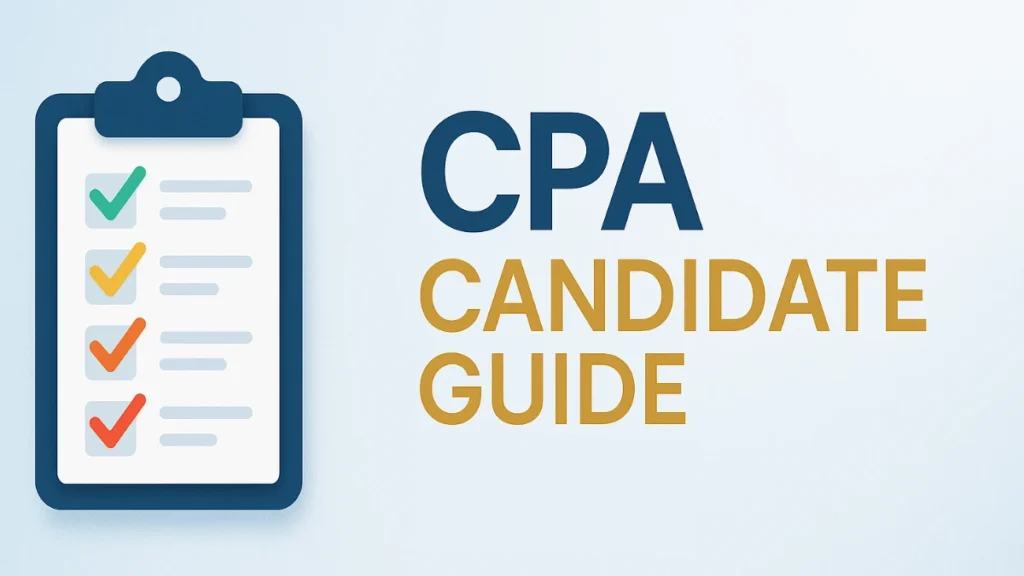The Certified Public Accountant (CPA) credential is one of the most prestigious licenses in the field of accounting. Whether you’re a recent graduate or a working professional, becoming a CPA opens doors to high-demand roles in public accounting, corporate finance, government, and beyond. But before you can earn that title, you must navigate the Uniform CPA Examination; a rigorous, four-part test that is as much about preparation as it is about perseverance.

CPA Exam Structure
Let’s begin with the basics: understanding the structure of the exam helps you plan your strategy for each section.
The CPA Exam is composed of four 4-hour sections:
- Core Sections (Mandatory):
- Auditing and Attestation (AUD)
- Financial Accounting and Reporting (FAR)
- Regulation (REG)
- Discipline Section (Choose one):
- Business Analysis and Reporting (BAR)
- Information Systems and Controls (ISC)
- Tax Compliance and Planning (TCP)
Each section contains a combination of Multiple-Choice Questions (MCQs) and Task-Based Simulations (TBSs). A passing score is 75 or higher, and you must complete all four sections within an 18-month rolling window.
Eligibility Requirements
Before diving into registration, confirm you’re eligible to sit for the CPA Exam.
CPA eligibility is determined by the Board of Accountancy in each of the 55 U.S. jurisdictions. Most jurisdictions require:
- 150 semester hours of education (typically a bachelor’s degree plus additional coursework)
- Completion of specific accounting and business courses
- In some cases, professional experience (1–2 years)
International candidates must also meet U.S. standards and may apply through selected jurisdictions offering international testing.
The Application Process
Here’s how to officially begin your CPA journey by applying to take the exam.
- Education Evaluation – Submit transcripts to verify academic eligibility.
- Exam Application – Apply online via NASBA or your jurisdiction’s CPA Examination Services (CPAES).
- Fee Submission – Pay application and exam fees as required.
- Notice to Schedule (NTS) – Once approved, you’ll receive an NTS to book your exam.
Pro Tip: Make sure your name matches exactly on your application, NTS, and IDs.
Scheduling the Exam
Once you’ve received your NTS, the next step is securing your testing date.
Use your NTS to schedule your exams at a Prometric testing center. Plan ahead:
- Schedule at least 5 days in advance
- Book early for your preferred location and time
- Your NTS typically remains valid for 6 months, depending on the jurisdiction
Two scheduling methods:
- Online at www.prometric.com/cpa
- Call Prometric: 800-580-9648 (U.S.)
Exam Fees and Rescheduling Policies
Understanding the fee structure and rescheduling rules will save you time, stress, and money.
There are typically two types of fees:
- Application Fee: Paid to your Board of Accountancy or CPAES
- Exam Fee: Paid for each section (ranges vary by state)
Rescheduling/Cancellation Fees:
- 30+ days before: $0
- 6–29 days: ~$35
- <5 days or no-show: Full forfeiture of fees
Preparing for the CPA Exam
Proper preparation is the key to passing the CPA Exam on the first attempt.
Must-use resources:
- AICPA Blueprints (exam content & skills)
- Sample Tests and Tutorials
- Prometric Test Drive (optional 30-min dry run)
Recommended CPA Review Courses:
- Becker, Surgent, Gleim, Roger CPA, Wiley
Tip: Create a 6–12 month study schedule. Focus on weak areas, and practice simulations often.
On Exam Day: What to Expect
Knowing what happens on test day helps you stay calm and confident.
- Arrive 30 minutes early
- Bring:
- Your NTS (printed or saved)
- Two forms of ID (one government-issued with photo and signature)
- Prometric will conduct fingerprinting, a photo, and ID checks
- You will have 4 hours per section, with a standardized break
Note: Exam centers are strict. Personal items, notes, electronics, and bags are prohibited.
Receiving Your Scores
After you take the test, here’s how and when to get your scores.
- Scores are released on a rolling basis, typically every few weeks
- View scores on your NASBA Candidate Portal
- If you fail, you must wait until your score is posted before reapplying for that section
Retaking the Exam
Didn’t pass a section? Here’s what to do next.
- You can retake failed sections in future testing windows (no waiting period as of 2024)
- Ensure your new NTS is issued before scheduling
- Keep track of your 18-month clock for passed sections
Final Tips for CPA Success
Wrap up your plan with these expert-tested strategies for acing the CPA exam journey.
- Treat the CPA journey like a project: deadlines, checklists, and deliverables
- Don’t underestimate the power of mock exams
- Understand the Candidate Guide, Blueprints, and Prometric protocols thoroughly
- Stay consistent. It’s a marathon, not a sprint
Helpful Links:

